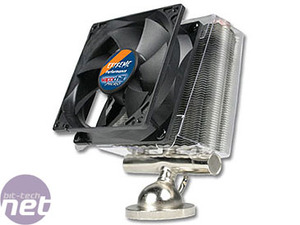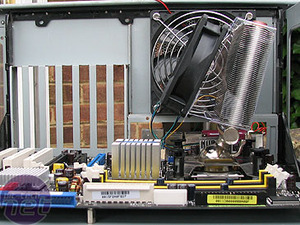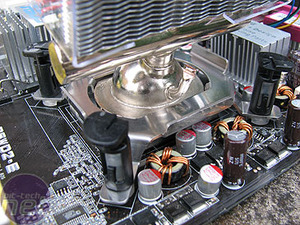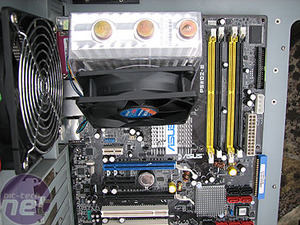Conroe heatsink group test
August 1, 2006 | 14:18
Companies: #akasa #alphacool #arctic-cooling #intel #thermaltake #zalman

Asetek Vapochill Micro Xtreme
Price: £25.78 inc VATSupplier: Scan
Manufacturer: Asetek
The Vapochill Micro is unique amongst the other coolers in this group test. While it does use heat pipes, it only uses one large chamber, over the copper base. This chamber, in turn, feeds three large heat pipes, which then pass through the aluminium fins.
The fin assembly is covered with a cowling, which has been folded from a 1mm thick acrylic sheet. The heat sink’s fan attaches to this cowling using press studs that hold the fan securely in position in front of the fins.


The clip that the pins attach to is free to slip around the base of the heat sink, which makes mounting the unit a pain. It’s actually worse than the Mini Typhoon’s clip system in practice, because of the tight fit, making it harder to get the clip to lie properly in place.
Noise: While the Vapochill’s 92mm fan comes with a four-pin connector, it doesn’t help reduce the noise the unit makes. Unlike the other heat sinks on test, the Vapochill rattles. Because the fan clips to a thin plastic shroud, and the shroud isn’t perfectly formed, there is a lot of mechanical noise.
Unfortunately this buzzing rattle is a lot louder than the fan, which in itself isn’t very quiet. Fortunately the Vapochill comes with a rheostat, which will allow you to lower the fanspeed manually.


It didn’t help the system temperature either. Although it’s a tall heatsing like the Auras, it doesn’t push its hot exhaust directly out of the case. Instead you must install it so that it blows directly upwards into the PSU.
Score:
Value 1
Performance order 2
Noise level 1
Assembly and mounting difficulty 2
Quality and aesthetic 2
Overall 2

MSI MPG Velox 100R Chassis Review
October 14 2021 | 15:04








Want to comment? Please log in.